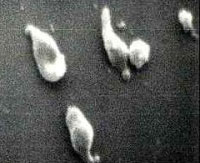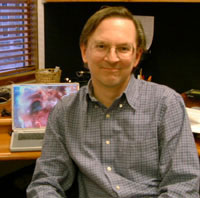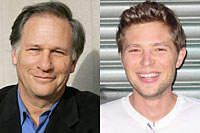
On this page, you'll find regularly updated audio, video, and text reports from our producers and correspondents. We invite you to join the discussion about topics covered here on our board and to subscribe to our audio and video podcasts to download these reports to your computer or MP3 player.

Remember me? Recall our last conversation, dear readers, Keep It Very Simple. 
Dr. Jack Szostak |
7.14.2005 Use Old PartsJonah Lehrer: Okay, to review: In session number one, we learned that a team of scientists have taken what's basically dust—lifeless chemicals—put 'em in a machine in a particular order and out came something very, very, very close to a living thing! Robert Krulwich: Yup, and the most amazing part, the thing that really got me— Lehrer: Let me guess: the "lightning" part? Krulwich: Yeah, what I call the "lightning" part—that the chemicals didn't need "lightning" or a Divine Breath to take the Big Leap. As soon as they were placed in the correct genetic sequence—the right order of A's and C's and T's and G's, the chemicals on their own stitched themselves together. It's almost like they looked at each other, held hands, and just weaved themselves into a virus, like they knew how. Lehrer: Yes, there's something deeply mysterious or majestic about this. Krulwich: And now the same team is going after the Biggest Prize of all. Lehrer: Yeah, that's what we talked about the last time we met: In two years they expect to create—not a virus, 'cause viruses are parasites, they aren't truly, fully alive—but Dr. Hamilton Smith and his partner Craig Venter told the Wall Street Journal in two years they expect to create a truly living thing from dust, chemical dust. Krulwich: And remind me how— Lehrer: By taking a stripped down, simple-as-it-gets bacterium— Krulwich: This guy on the left? Lehrer: This is the guy. It's composed of 512 genes, made from hundreds of thousands of chemical ingredients. And by putting all those chemicals together in the right order and— Krulwich: With no lightning added— Lehrer: Right. With no lightning added they hope all those A's and C's and T's and G's will link up and out will pop ... a working bacterium! Krulwich: A new life? Lehrer: Yeah, a working copy of a living bacterium: man-made life. Krulwich: So that's two years from now ... Meantime...? Lehrer: Meantime, let's make this even more interesting. Krulwich: How? Lehrer: Well, so far what the scientists have done is they've carefully put the A's, C's, T's, and G's in a precise order. If a virus in real life is built from chemicals ordered, say, like this: AAA CCC TTT GGG ...in their experiment, the scientists put the chemicals into their machine in the exact same order: AAA CCC TTT GGG Krulwich: So? Lehrer: So, that's kind of a cheat. Krulwich: Why? Lehrer: 'Cause if life on Earth came about by accident, if chemicals just happened to bump into each other in the right configuration, then what scientists want to do is create the same "accident" a second time. Krulwich: Oh, I see. "Arranging" the chemicals like a recipe is not an accident. Lehrer: Exactly. What would really be amazing is if you could put all the chemicals necessary for primitive life into a jug and then shake and shake and shake and shake, creating combination after combination after combination after combination, until maybe, just maybe— Krulwich: You "accidentally" create a living thing? Lehrer: Well, at least the first step toward a living thing, yes. So Dr. Jack Szostak, a professor of genetics at Harvard, you'll pardon the pun, is giving it a shot. He is creating hundreds of millions of combinations, hoping to produce an accidental cocktail in his lab that might be useful. Krulwich: "Useful?" Doesn't he want to create a living thing? Lehrer: Eventually. But he'd be happy to do this in steps. Krulwich: What kind of steps? Lehrer: Well, Dr. Szostak has noticed that when chemicals link into combinations, when they become, say, molecules, some of those molecules get sticky. They are good at attracting, or sticking to, other molecules. Szostak found that the more complex a molecule is, the better it is at binding. Krulwich: So? Lehrer: Well, if creating life is about creating chemical combinations, this is important. Krulwich: You mean, before a molecule can become a living thing, it has to be sticky? Lehrer: Kinda, yeah. Take a DNA molecule, which some believe is related to one of the first life-forms. DNA actually has two separate strands that stick to each other. So you see, stickiness could have led to come early molecules of astonishing complexity. Krulwich: The point here being... Lehrer: The point here is that Dr. Szostak is proposing that over enough time, once molecules achieved extra stickiness, they could stick themselves into billions of accidental combinations and gradually acquire higher and higher levels of organization, eventually leading— Krulwich: —to the ever-so-sticky combinations of molecules called ... me! Lehrer: Well, I don't think Szostak was thinking of you exactly. But the point is this is an approach that says one day you can get life from non-life by starting at the bottom with raw, lifeless chemicals, which you shake and shake until you get a degree of accidental stickiness, and that stickiness will, you hope, eventually forge a path to, well, to life. Krulwich: What do you call this? Lehrer: They call this "Bottom Up" method. Krulwich: As opposed to...? Lehrer: As opposed to "Top Down," where you start with a recipe. Krulwich: Both are ways to create life? Lehrer: Dr. Szostak is trying Bottom Up; Doctors Smith and Venter, both of whom we introduced our dear readers to in parts one and two of this series, are trying Top Down. Krulwich: I hesitate to ask, but is there a middle way? Lehrer: Well, since you asked... Krulwich: Uh oh. Lehrer: There is one more. Krulwich: Oh no.
Lehrer: Oh yes. Stay tuned.
|
|||||||||||

Robert Krulwich is host and executive editor of NOVA scienceNOW. Jonah Lehrer is a NOVA scienceNOW online contributing editor. He recently completed a Rhodes scholarship at Oxford University's Wolfson College. |
||||||||||||
|
© | Created July 2005 |
||||||||||||